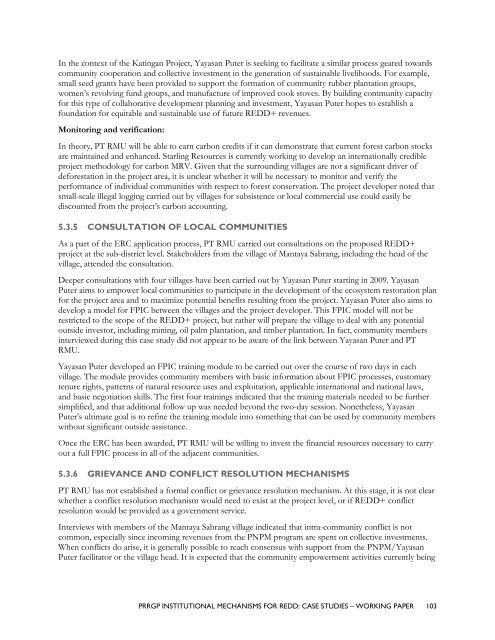Institutional Mechanisms for REDD+ - Case Studies Working Paper
Institutional Mechanisms for REDD+ - Case Studies Working Paper
Institutional Mechanisms for REDD+ - Case Studies Working Paper
You also want an ePaper? Increase the reach of your titles
YUMPU automatically turns print PDFs into web optimized ePapers that Google loves.
In the context of the Katingan Project, Yayasan Puter is seeking to facilitate a similar process geared towards<br />
community cooperation and collective investment in the generation of sustainable livelihoods. For example,<br />
small seed grants have been provided to support the <strong>for</strong>mation of community rubber plantation groups,<br />
women‘s revolving fund groups, and manufacture of improved cook stoves. By building community capacity<br />
<strong>for</strong> this type of collaborative development planning and investment, Yayasan Puter hopes to establish a<br />
foundation <strong>for</strong> equitable and sustainable use of future <strong>REDD+</strong> revenues.<br />
Monitoring and verification:<br />
In theory, PT RMU will be able to earn carbon credits if it can demonstrate that current <strong>for</strong>est carbon stocks<br />
are maintained and enhanced. Starling Resources is currently working to develop an internationally credible<br />
project methodology <strong>for</strong> carbon MRV. Given that the surrounding villages are not a significant driver of<br />
de<strong>for</strong>estation in the project area, it is unclear whether it will be necessary to monitor and verify the<br />
per<strong>for</strong>mance of individual communities with respect to <strong>for</strong>est conservation. The project developer noted that<br />
small-scale illegal logging carried out by villages <strong>for</strong> subsistence or local commercial use could easily be<br />
discounted from the project‘s carbon accounting.<br />
5.3.5 CONSULTATION OF LOCAL COMMUNITIES<br />
As a part of the ERC application process, PT RMU carried out consultations on the proposed <strong>REDD+</strong><br />
project at the sub-district level. Stakeholders from the village of Mantaya Sabrang, including the head of the<br />
village, attended the consultation.<br />
Deeper consultations with four villages have been carried out by Yayasan Puter starting in 2009. Yayasan<br />
Puter aims to empower local communities to participate in the development of the ecosystem restoration plan<br />
<strong>for</strong> the project area and to maximize potential benefits resulting from the project. Yayasan Puter also aims to<br />
develop a model <strong>for</strong> FPIC between the villages and the project developer. This FPIC model will not be<br />
restricted to the scope of the <strong>REDD+</strong> project, but rather will prepare the village to deal with any potential<br />
outside investor, including mining, oil palm plantation, and timber plantation. In fact, community members<br />
interviewed during this case study did not appear to be aware of the link between Yayasan Puter and PT<br />
RMU.<br />
Yayasan Puter developed an FPIC training module to be carried out over the course of two days in each<br />
village. The module provides community members with basic in<strong>for</strong>mation about FPIC processes, customary<br />
tenure rights, patterns of natural resource uses and exploitation, applicable international and national laws,<br />
and basic negotiation skills. The first four trainings indicated that the training materials needed to be further<br />
simplified, and that additional follow up was needed beyond the two-day session. Nonetheless, Yayasan<br />
Puter‘s ultimate goal is to refine the training module into something that can be used by community members<br />
without significant outside assistance.<br />
Once the ERC has been awarded, PT RMU will be willing to invest the financial resources necessary to carry<br />
out a full FPIC process in all of the adjacent communities.<br />
5.3.6 GRIEVANCE AND CONFLICT RESOLUTION MECHANISMS<br />
PT RMU has not established a <strong>for</strong>mal conflict or grievance resolution mechanism. At this stage, it is not clear<br />
whether a conflict resolution mechanism would need to exist at the project level, or if <strong>REDD+</strong> conflict<br />
resolution would be provided as a government service.<br />
Interviews with members of the Mantaya Sabrang village indicated that intra-community conflict is not<br />
common, especially since incoming revenues from the PNPM program are spent on collective investments.<br />
When conflicts do arise, it is generally possible to reach consensus with support from the PNPM/Yayasan<br />
Puter facilitator or the village head. It is expected that the community empowerment activities currently being<br />
PRRGP INSTITUTIONAL MECHANISMS FOR REDD: CASE STUDIES – WORKING PAPER 103

















